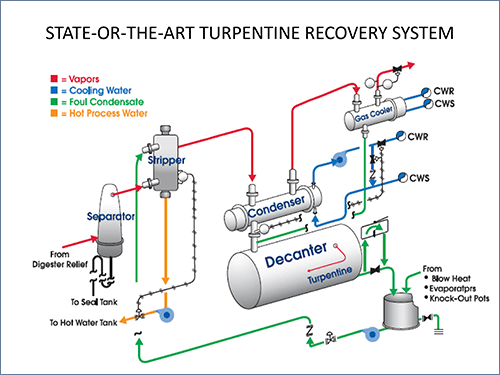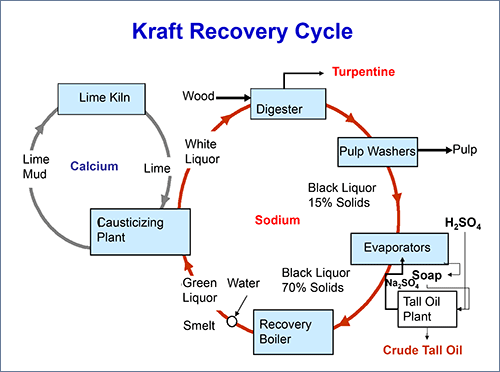Industry News
Is Your Recovery Process Up To Snuff?

Industry News

Link: Is Your Recovery Process Up To Snuff? | PCA
By: Charles Morris
The efficient recovery of black liquor soap (BLS), crude tall oil (CTO) and crude sulfate turpentine (CST) is an often overlooked opportunity for pulp mills trying to improve throughput and revenue.
Why overlooked? To some mill operators, the recovery process is considered a secondary priority next to producing pulp and paper. “We’re in the business of making pulp and paper, not byproducts,” they say. Certainly this is true, but with this secondary status, entry-level engineers are frequently put in charge of pulp mill recovery operations, and given few resources from which to learn the basics of recovery technologies. They often do not have a full appreciation of either the revenue value to the mill, the operational costs of bottlenecks caused by not removing black liquor soap prior to the recovery furnace, and the safety hazards.

Figure 1. State or The Art, Turpentine Recovery System © PCA
Poor recovery processes often result in an unsafe mill. CST is flammable and could ignite or explode as a result of a static electricity discharge. Additionally, it is often high in hydrogen sulfide gas (H2S) concentration and can be toxic when inhaled. CST historically has been recovered from the condensed steam exiting the digesters. Today, however, with the increasingly closed systems used by mills, CST is appearing in other areas downstream of the digester. Mill engineers must then track down the CST and remove it before a potentially harmful incident occurs. One recovery specialist refers to this process as “looking for CST in all the wrong places.”
There is a good market for CST and CTO, as these products are fractionated into intermediate products used in inks, adhesives, paints, rubber used in tires, coatings, vitamin intermediates, fragrances and perfumes, flavors and a number of food additives. The revenue generated from CTO and CST sales helps increase mill profits.
Inefficient recovery furnace operations – when unrecovered BLS is burned in the furnace rather than captured, for example – are often central to mill bottlenecks that slow down the process, resulting in reduced production and lost revenue potential. The recovered product could be sold to one of the many industries that rely on CTO- and CST-based products.

Figure 2. Kraft Recovery Cycle © PCA
There are a number of defined “best practices” in handling CST, soap and CTO that can improve mill output and safety. To realize the benefits, of efficient recovery, mills must focus on specific areas for recovery improvement. These include:
> Understanding the technology and methods to maximize BLS, CTO and CST yields.
> Improving safety best practices, particularly in CST recovery processes.
> Best practices in acidulating soap to produce CTO and techniques to improve yields.
> Reviewing troubleshooting methodology in recovery systems.
From mill operators to process engineers, and pulp mill managers to recovery and technical superintendents, knowledge of the recovery best practices throughout the plant is critical to improved performance.
On that end, last year the Pine Chemicals Association, in partnership with TAPPI, began offering a three-day course: Soap and Turpentine Recovery and Tall Oil Processing. The recovery course teaches participants the basics of design and efficient operation of recovery systems as well as CTO production. It covers recovery technology for both soap and CST, safety best practices, testing and logistics. It is the only course of its kind in the world, the most recent session was held March 10-12 in Atlanta. In 2014 more than 80 people from around the globe attended the first presentation of this course.

Figure 3. Impact of Soap Content in Liquor on Evaporator Heat Transfer Coefficient Loss © PCA
Gaining the know-how to put best practices in place will result in significant improvements in the recovery process, which include:
A study defining the nature and extent of scaling problems-the buildup of deposits in the recovery boiler in the alkaline pulping industry found that more than 75% of the responding mills reported encountering one or more types of scales. The most commonly encountered scales were calcium scales and soluble Na2CO3-Na2SO4 scales. Others have shown that soap is a significant scale component, particularly in soluble carbonate-sulfate scales in evaporators and concentrators. Mill and pilot plant studies have been done to clarify the importance of soap in evaporator scale formation and quantify its effect on scaling rates. Similarly other studies have found that tall oil soap addition to black liquor increased calcium scaling by about 30%.
Besides the evaporator scaling impact, the presence of soap reduces the liquor burning capacity of solids limited and steam-side limited recovery boilers. In solids-limited recovery boilers, a given mass of soap will displace an equivalent mass of black liquor solids. In a steam-side limited boiler, a given mass of soap will displace about twice the equivalent mass of black liquor solids. Pulping capacity will be directly affected.
It has been found that the burning of soap, even at low concentrations, increased total reduced sulfur (TRS) emissions. The boiler fouling rate also increased at a given liquor firing rate. Studies have shown that a connection may exist between liquor soap content and the occurrence of blackouts in kraft recovery boilers.
Furthermore, soap that accumulates in heavy liquor storage tanks generally does not form a defined bed. As a result, it tends to be fed to the recovery boiler in “slugs”. To prevent black outs, operators are forced to increase the primary air supply. This results in more oxidation of the bed and lower reduction efficiencies. In one mill that improved its soap recovery from 20 lb to 35 lb CTO/1,000 lb black liqur solids, reduction efficiencies increased from 84% to 92%, in addition to the anticipated 10% improvement in evaporator throughput. They also experienced improved green liquor clarification.
Studies have shown that sodium soaps of resin acids present in the waste streams of kraft mills contribute to over 80% of the toxicity of the effluent, and are primary cause of fish mortality. Sodium salts of the unsaturated fatty acids accounted for the remaining toxicity.
Soap storage tanks not properly managed can foam over and result in added load to the mill effluent system. By its nature soap has a high BOD load. Likewise, CST is lost from spills, leaks and decanter underflow again contributing to BOD.
If a mill is recausticizing-limited, soap represents a larger causticization load per/ton of solids fired in the recovery boiler than does black liquor solids. This is because soap burns to sodium carbonate (Na2CO3), whereas black liquor solids burn and reduce to a mixture of sodium carbonate and sodium sulfide (Na2S). The sodium sulfide does not require causticization after dissolution in the green liquor.
The bottom line is that improving the recovery of black liquor soap and CST offers many advantages to a pulp mill. With proper focus this frequently overlooked source of revenue and mill throughput can make a difference in mill safety, efficiency and profits.
Copyright of this article by PCA. We are sharing and promoting the market innovation.
If you like this article, kindly to visit www.pinechemicals.org